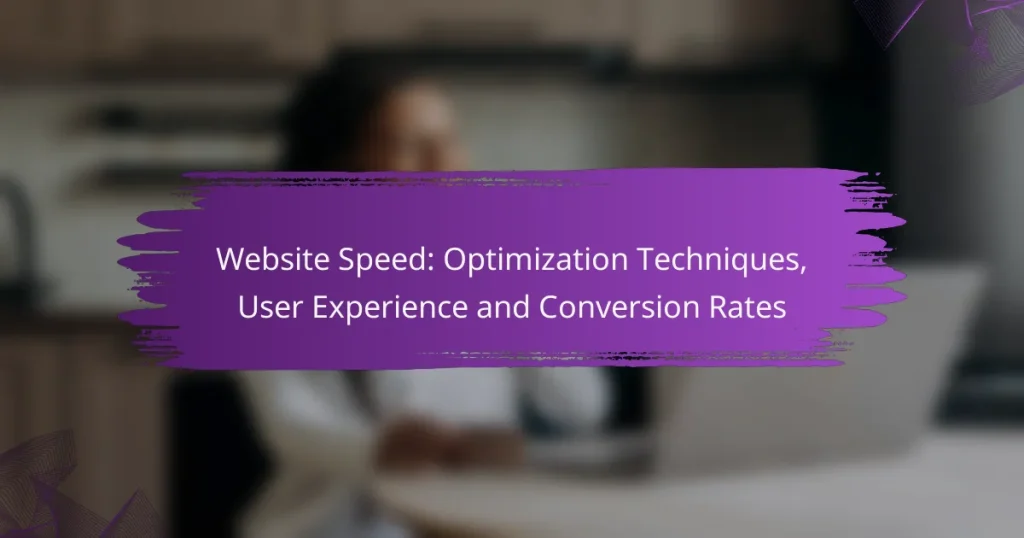E-commerce marketing solutions are essential for optimizing conversion rates and driving sales in a competitive online landscape. By employing strategies such as email marketing automation, personalized recommendations, and A/B testing, businesses can effectively engage customers and enhance their shopping experience. Additionally, factors like website speed play a critical role in influencing user satisfaction and reducing abandonment rates.
A/B Testing: Methodology, Implementation and Sales Impact
Cart Abandonment: Strategies, Causes and Recovery Techniques
Customer Feedback: Collection Methods, Analysis and Conversion Enhancement
Website Speed: Optimization Techniques, User Experience and Conversion Rates
What are the best e-commerce marketing solutions for increasing conversion rates?
The best e-commerce marketing solutions for increasing conversion rates include strategies like email marketing automation, personalized product recommendations, social media advertising, search engine optimization, and retargeting campaigns. These methods help engage customers effectively and drive sales by enhancing the shopping experience.
Email marketing automation
Email marketing automation allows businesses to send targeted messages to customers based on their behavior, preferences, and purchase history. By automating campaigns, e-commerce sites can nurture leads and encourage repeat purchases without manual effort.
Consider segmenting your email list to tailor content for different customer groups. For instance, sending special offers to customers who haven’t purchased in a while can significantly boost conversion rates.
Personalized product recommendations
Personalized product recommendations leverage customer data to suggest items that align with individual preferences. This approach enhances the shopping experience and increases the likelihood of additional purchases.
Using algorithms to analyze past purchases and browsing behavior can help you create effective recommendations. For example, displaying related items on product pages or in follow-up emails can lead to higher average order values.
Social media advertising
Social media advertising enables e-commerce businesses to reach targeted audiences through platforms like Facebook, Instagram, and TikTok. These ads can be tailored to specific demographics, interests, and behaviors, making them highly effective for driving traffic and conversions.
Utilizing visually appealing content and clear calls-to-action in your ads can improve engagement. Experimenting with different ad formats, such as carousel ads or video ads, can also yield better results.
Search engine optimization
Search engine optimization (SEO) is crucial for improving your e-commerce site’s visibility in search engine results. By optimizing product descriptions, images, and site structure, you can attract more organic traffic and increase conversion rates.
Focus on keyword research to identify terms your target audience is searching for. Additionally, ensure your site is mobile-friendly and loads quickly, as these factors significantly impact user experience and search rankings.
Retargeting campaigns
Retargeting campaigns target users who have previously visited your site but did not complete a purchase. By displaying ads to these potential customers as they browse other sites, you can remind them of their interest and encourage them to return.
Utilizing platforms like Google Ads or Facebook Ads for retargeting can be effective. Consider offering incentives, such as discounts or free shipping, to entice users back to your site and complete their purchase.
How can A/B testing improve conversion rates?
A/B testing can significantly enhance conversion rates by allowing businesses to compare two versions of a webpage or marketing element to determine which performs better. By systematically testing variations, marketers can identify effective strategies that resonate with their audience and drive more conversions.
Identifying effective design elements
To identify effective design elements, focus on key aspects such as layout, color schemes, and typography. A/B testing different designs can reveal which combinations capture user attention and encourage engagement. For example, testing a minimalist layout against a more complex one may show that simplicity leads to higher conversion rates.
Consider running tests on images and videos as well. Visual content can significantly impact user behavior, so experimenting with different visuals can help determine what best resonates with your target audience.
Optimizing call-to-action buttons
Optimizing call-to-action (CTA) buttons is crucial for improving conversion rates. A/B testing different button colors, sizes, and placements can reveal which variations lead to more clicks. For instance, a bright, contrasting color may attract more attention than a muted tone.
Additionally, the wording on the button matters. Phrases like “Get Started” or “Join Now” can be more compelling than generic terms like “Submit.” Test various phrases to see which ones drive higher engagement and conversions.
What role does website speed play in e-commerce conversions?
Website speed is crucial for e-commerce conversions as it directly influences user satisfaction and purchasing decisions. A faster site can significantly reduce abandonment rates and enhance overall customer engagement.
Impact on user experience
A fast-loading website creates a seamless user experience, allowing customers to navigate effortlessly. When pages load quickly, users are more likely to explore products and complete purchases without frustration. Aim for a loading time of under three seconds to keep visitors engaged.
Consider optimizing images, leveraging browser caching, and minimizing server response times to enhance speed. Tools like Google PageSpeed Insights can help identify areas for improvement.
Correlation with bounce rates
Website speed is closely linked to bounce rates, which measure the percentage of visitors who leave after viewing only one page. Studies indicate that even a one-second delay can increase bounce rates by a significant margin, often exceeding 30%. This means that slow sites risk losing potential customers.
To minimize bounce rates, regularly test your website’s performance and address any speed issues promptly. Implementing a content delivery network (CDN) can also help distribute load times more evenly across different regions, improving access for international customers.
How can customer reviews enhance e-commerce marketing?
Customer reviews significantly enhance e-commerce marketing by building trust and improving product visibility. Positive feedback from previous buyers can influence potential customers’ purchasing decisions, leading to higher conversion rates.
Building trust with potential buyers
Trust is crucial in e-commerce, where customers cannot physically inspect products before buying. Customer reviews provide social proof, which reassures potential buyers about the quality and reliability of a product. Brands that showcase authentic reviews often see increased customer confidence and loyalty.
To maximize trust-building, encourage satisfied customers to leave reviews and respond to feedback, both positive and negative. This engagement shows that the brand values customer opinions and is committed to improving the shopping experience.
Improving product visibility
Customer reviews can enhance product visibility on e-commerce platforms by improving search rankings. Many algorithms prioritize products with higher ratings and more reviews, making them more likely to appear in search results. This increased visibility can lead to more traffic and potential sales.
To leverage reviews for visibility, consider implementing a review solicitation strategy post-purchase. Sending follow-up emails or offering incentives for leaving reviews can help gather more feedback, boosting both the quantity and quality of reviews associated with your products.
What are the key metrics for measuring conversion rates?
Key metrics for measuring conversion rates include conversion rate percentage, average order value, and cart abandonment rate. These metrics provide insights into customer behavior and the effectiveness of marketing strategies, helping businesses identify areas for improvement.
Conversion rate percentage
The conversion rate percentage is calculated by dividing the number of conversions by the total number of visitors, then multiplying by 100. A typical conversion rate for e-commerce sites ranges from 1% to 3%, though high-performing sites can achieve rates above 5%. Regularly monitoring this metric helps assess the effectiveness of marketing campaigns and website optimization efforts.
To improve your conversion rate, focus on enhancing user experience, optimizing product pages, and utilizing targeted marketing strategies. A/B testing different elements, such as call-to-action buttons and page layouts, can also yield valuable insights.
Average order value
Average order value (AOV) is the average amount spent by customers per transaction. It is calculated by dividing total revenue by the number of orders. AOV can vary widely across industries, but increasing it is crucial for boosting overall revenue without needing to acquire more customers.
Strategies to increase AOV include offering product bundles, upselling related items, and providing discounts on minimum purchase amounts. For instance, if a customer spends over $50, offering a 10% discount can encourage them to add more items to their cart.
Cart abandonment rate
The cart abandonment rate measures the percentage of shoppers who add items to their cart but do not complete the purchase. This rate typically hovers around 60% to 80% for e-commerce sites. Understanding why customers abandon their carts is essential for reducing this metric and increasing conversions.
Common reasons for cart abandonment include high shipping costs, complicated checkout processes, and lack of payment options. To combat this, simplify the checkout experience, offer transparent shipping costs, and provide multiple payment methods. Sending follow-up emails to remind customers about their abandoned carts can also help recover lost sales.
What are the prerequisites for effective e-commerce marketing?
Effective e-commerce marketing requires a deep understanding of your target audience and well-defined marketing goals. These elements form the foundation for strategies that can significantly enhance conversion rates.
Understanding target audience
Identifying your target audience is crucial for tailoring marketing efforts. This involves analyzing demographics, preferences, and behaviors to create customer personas that guide your messaging and product offerings.
Utilize tools like Google Analytics or social media insights to gather data on your audience. Consider factors such as age, gender, location, and purchasing habits to refine your approach and ensure it resonates with potential customers.
Setting clear marketing goals
Establishing clear marketing goals helps measure success and directs your strategies. Goals should be specific, measurable, achievable, relevant, and time-bound (SMART) to ensure they are realistic and actionable.
For instance, aim to increase website traffic by a certain percentage over a defined period or boost conversion rates by optimizing product pages. Regularly review these goals to adjust tactics as needed and stay aligned with market trends.
How can mobile optimization affect e-commerce success?
Mobile optimization significantly impacts e-commerce success by enhancing user experience and increasing conversion rates. A well-optimized mobile site ensures that visitors can easily navigate, find products, and complete purchases, which is crucial as mobile traffic continues to rise.
Increasing mobile traffic
To boost mobile traffic, e-commerce businesses should prioritize responsive design, ensuring their websites adapt seamlessly to various screen sizes. This approach not only improves user experience but also aligns with search engine algorithms that favor mobile-friendly sites.
Utilizing mobile-specific marketing strategies, such as SMS promotions and location-based advertising, can further attract mobile users. For instance, offering exclusive discounts via text messages can encourage immediate purchases and increase engagement.
Additionally, optimizing for local search can drive more mobile traffic. Businesses should ensure their listings on platforms like Google My Business are updated and accurate, as many consumers search for nearby stores or services using their mobile devices.


